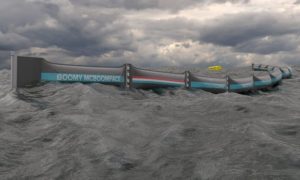Source: theguardian.com
Published: June 22, 2016

The barrier will be towed 12 miles out to sea for a year of sensor-monitored tests. Photograph: The Ocean Cleanup
If tests of the 100 metre-long barrier that collects rubbish on the sea’s surface are successful, it could be deployed at a larger scale in the ‘great Pacific garbage patch’
A bid to clear the Pacific of its plastic debris has moved a step closer with the launch of the biggest prototype clean-up boom yet by the Dutch environment minister at a port in The Hague.
On Thursday the 100 metre-long barrier will be towed 12 miles (20km) out to sea for a year of sensor-monitored tests, before being scaled up for real-life trials off the Japanese coast at the end of next year.
If all goes well, full-scale deployment of a 100km-long version will take place in the “great Pacific garbage patch” between California and Hawaii in 2020.
The Dutch environment minister, Sharon Dijksma, told the Guardian that her government, which part-funded the test, was fully backing the project, which will eventually cost about £230m (€300m).
“We can use our political pressure with other governments, businesses and the international institutions to fund this on an even bigger scale,” she said. “We are used to fronting public-private [partnerships] like this. It is not new for us. When it is a success, philanthropists will be standing in line asking to join us.”
The snake-like ocean barrier is made out of vulcanised rubber and works by harnessing sea currents to passively funnel floating rubbish – often just millimetres wide – into a cone.
A cable sub-system will anchor the structure at depths of up to 4,500 metres – almost twice as far down as has even been done before – keeping it in place so it can trap the rubbish for periodic collection by boats.
A fully scaled-up barrier would be the most ambitious ocean-cleansing project yet, capturing about half of the plastic soup that circles the north Pacific gyre – one of several large systems of rotating ocean currents – within a decade. That at least is the plan.
The largely crowd-funded project has caught the imagination of a new generation in the Netherlands. In no small part this is down to the unaffected charisma of its 21-year-old founder, Boyan Slat, a student dropout who has become an environmental entrepreneur.
“The key objective of these tests is to see if we can build something that can survive at sea for years if not decades,” he said. “We want to test the efficiency of the system, understand its behaviour, and see what damage it suffers over time from abrasion or fatigue.”
After promising tests at the Marin research institute in Wageningen earlier this year, the prototype was developed with a renowned dredging and marine contractor, Royal Boskalis Westminster. Peter Berdowski, the firm’s CEO, described it as “a wonderful concept” and “very inspiring”.
The Dutch government is so convinced of its feasibility that it is taking Slat to Indonesia in November, as part of a high-level climate and trade mission, led by the prime minister, Mark Rutte.
Discussions are likely to focus on the possibility of attaching the barrier to the mouths of rivers as a way of staunching the 800 tonnes of plastic that flow into the Pacific and Indian oceans every year.
Dijksma said: “We will try to see if there is a possibility to put this project in place with the Indonesian government too. We have not done the deal yet. But the fact that Boyan will be in the delegation is important because we only take people with us when we think they offer solutions that could be interesting for other governments.”
With up to 29.1 items of rubbish per square metre, the Indonesian archipelago has the world’s second-highest concentration of shoreline marine debris after Sicily, which has 231 items per square metre.
In 2014, 311m tonnes of plastic were produced around the world, a 20-fold increase since 1964. It is expected to quadruple again by mid-century.
A report by the Ellen MacArthur Foundation earlier this year predicted that there would be more plastic than fish in the oceans by 2050 unless urgent action was taken.
